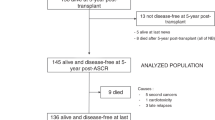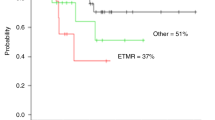Abstract
We retrospectively analysed the outcomes of children transplanted for high-risk neuroblastoma (NB) at a single institution predominantly transplanted with total body irradiation and chemotherapy. The aims of this study were to determine the prognostic impact of clinical and biological features and to document long-term health outcomes. Forty patients were transplanted with a single unpurged autograft. Fourteen patients died from disease progression and two from late complications of treatment. Twenty-three patients are alive at a median of 4.6 years from diagnosis. Kaplan–Meier estimates of overall survival at 2, 5 and 10 years are 76±7.0, 60.2±8.4 and 54.7±9.3% following transplant. Response to induction therapy was significantly associated with survival (P<0.01). Long-term complications included growth (100%) and pubertal failure (83%), hearing impairment (73%), orthopaedic complications (63%), renal impairment (47%) and thyroid abnormalities (36%). Intrinsic and acquired resistance to chemotherapy remains the major obstacle to improving outcomes in high-risk NB. Although patients with chemo-sensitive disease are less likely to experience a relapse, substantial therapy-related toxicities result in poor long-term health outcomes for survivors.
This is a preview of subscription content, access via your institution
Access options
Subscribe to this journal
Receive 12 print issues and online access
$259.00 per year
only $21.58 per issue
Buy this article
- Purchase on Springer Link
- Instant access to full article PDF
Prices may be subject to local taxes which are calculated during checkout

Similar content being viewed by others
References
Philip T, Ladenstein R, Lasset C, Hartmann O, Zucker JM, Pinkerton R et al. 1070 myeloablative megatherapy procedures followed by stem cell rescue for neuroblastoma: 17 years of European experience and conclusions. European Group for Blood and Marrow Transplant Registry Solid Tumour Working Party. Eur J Cancer 1997; 33: 2130–2135.
Ladenstein R, Philip T, Lasset C, Hartmann O, Garaventa A, Pinkerton R et al. Multivariate analysis of risk factors in stage 4 neuroblastoma patients over the age of one year treated with megatherapy and stem-cell transplantation: a report from the European bone marrow transplantation solid tumor registry. J Clin Oncol 1998; 16: 953–965.
Eguchi H, Takaue Y, Kawano Y, Watanabe A, Watanabe T, Kikuta A et al. Peripheral blood stem cell autografts for the treatment of children over 1 year old with stage IV neuroblastoma: a long-term follow-up. Bone Marrow Transplant 1998; 21: 1011–1014.
Kaneko M, Tsuchida Y, Uchino J, Takeda T, Iwafuchi M, Ohnuma N et al. Treatment results of advanced neuroblastoma with the first Japanese study group protocol. Study group of Japan for treatment of advanced neuroblastoma. J Pediatr Hematol Oncol 1999; 21: 190–197.
Hartmann O, Valteau-Couanet D, Vassal G, Lapierre V, Brugieres L, Delgado R et al. Prognostic factors in metastatic neuroblastoma in patients over 1 year of age treated with high-dose chemotherapy and stem cell transplantation: a multivariate analysis in 218 patients treated in a single institution. Bone Marrow Transplant 1999; 23: 789–795.
Matthay KK, Villablanca JG, Seeger RC, Stram DO, Harris RE, Ramsay NK et al. Treatment of high-risk neuroblastoma with intensive chemotherapy, radiotherapy, autologous bone marrow transplantation, and 13-cis-retinoic acid. Children's cancer group. N Engl J Med 1999; 341: 1165–1173.
Frappaz D, Michon J, Coze C, Berger C, Plouvier E, Lasset C et al. LMCE3 treatment strategy: results in 99 consecutively diagnosed stage 4 neuroblastomas in children older than 1 year at diagnosis. J Clin Oncol 2000; 18: 468–476.
Castel V, Canete A, Navarro S, Garcia-Miguel P, Melero C, Acha T et al. Outcome of high-risk neuroblastoma using a dose intensity approach: improvement in initial but not in long-term results. Med Pediatr Oncol 2001; 37: 537–542.
De Bernardi B, Nicolas B, Boni L, Indolfi P, Carli M, Cordero Di ML et al. Disseminated neuroblastoma in children older than one year at diagnosis: comparable results with three consecutive high-dose protocols adopted by the Italian co-operative group for neuroblastoma. J Clin Oncol 2003; 21: 1592–1601.
Berthold F, Boos J, Burdach S, Erttmann R, Henze G, Hermann J et al. Myeloablative megatherapy with autologous stem-cell rescue versus oral maintenance chemotherapy as consolidation treatment in patients with high-risk neuroblastoma: a randomised controlled trial. Lancet Oncol 2005; 6: 649–658.
Pritchard J, Cotterill SJ, Germond SM, Imeson J, de KJ, Jones DR . High dose melphalan in the treatment of advanced neuroblastoma: results of a randomised trial (ENSG-1) by the European neuroblastoma study group 1. Pediatr Blood Cancer 2005; 44: 348–357.
Cotterill SJ, Pearson AD, Pritchard J, Foot AB, Roald B, Kohler JA et al. Clinical prognostic factors in 1277 patients with neuroblastoma: results of The European neuroblastoma study group ‘survey’ 1982–1992. Eur J Cancer 2000; 36: 901–908.
Matthay KK, Edeline V, Lumbroso J, Tanguy ML, Asselain B, Zucker JM et al. Correlation of early metastatic response by 123I-metaiodobenzylguanidine scintigraphy with overall response and event-free survival in stage IV neuroblastoma. J Clin Oncol 2003; 21: 2486–2491.
Matthay KK, Atkinson JB, Stram DO, Selch M, Reynolds CP, Seeger RC . Patterns of relapse after autologous purged bone marrow transplantation for neuroblastoma: a Childrens Cancer Group pilot study. J Clin Oncol 1993; 11: 2226–2233.
Seeger RC, Reynolds CP, Gallego R, Stram DO, Gerbing RB, Matthay KK . Quantitative tumor cell content of bone marrow and blood as a predictor of outcome in stage IV neuroblastoma: a Children's Cancer Group Study. J Clin Oncol 2000; 18: 4067–4076.
Burchill SA, Lewis IJ, Abrams KR, Riley R, Imeson J, Pearson AD et al. Circulating neuroblastoma cells detected by reverse transcriptase polymerase chain reaction for tyrosine hydroxylase mRNA are an independent poor prognostic indicator in stage 4 neuroblastoma in children over 1 year. J Clin Oncol 2001; 19: 1795–1801.
Kushner BH, Cheung NK, Kramer K, Heller G, Jhanwar SC . Neuroblastoma and treatment-related myelodysplasia/leukemia: the Memorial Sloan-Kettering experience and a literature review. J Clin Oncol 1998; 16: 3880–3889.
Parsons SK, Neault MW, Lehmann LE, Brennan LL, Eickhoff CE, Kretschmar CS et al. Severe ototoxicity following carboplatin-containing conditioning regimen for autologous marrow transplantation for neuroblastoma. Bone Marrow Transplant 1998; 22: 669–674.
Li Y, Womer RB, Silber JH . Predicting cisplatin ototoxicity in children: the influence of age and the cumulative dose. Eur J Cancer 2004; 40: 2445–2451.
Kushner BH, Budnick A, Kramer K, Modak S, Cheung NK . Ototoxicity from high-dose use of platinum compounds in patients with neuroblastoma. Cancer 2006; 107: 417–422.
Willi SM, Cooke K, Goldwein J, August CS, Olshan JS, Moshang Jr T . Growth in children after bone marrow transplantation for advanced neuroblastoma compared with growth after transplantation for leukemia or aplastic anemia. J Pediatr 1992; 120: 726–732.
Giorgiani G, Bozzola M, Locatelli F, Picco P, Zecca M, Cisternino M et al. Role of busulfan and total body irradiation on growth of prepubertal children receiving bone marrow transplantation and results of treatment with recombinant human growth hormone. Blood 1995; 86: 825–831.
Hovi L, Saarinen-Pihkala UM, Vettenranta K, Lipsanen M, Tapanainen P . Growth in children with poor-risk neuroblastoma after regimens with or without total body irradiation in preparation for autologous bone marrow transplantation. Bone Marrow Transplant 1999; 24: 1131–1136.
Laverdiere C, Cheung NK, Kushner BH, Kramer K, Modak S, LaQuaglia MP et al. Long-term complications in survivors of advanced stage neuroblastoma. Pediatr Blood Cancer 2005; 45: 324–332.
Notteghem P, Soler C, Dellatolas G, Kieffer-Renaux V, Valteau-Couanet D, Raimondo G et al. Neuropsychological outcome in long-term survivors of a childhood extracranial solid tumor who have undergone autologous bone marrow transplantation. Bone Marrow Transplant 2003; 31: 599–606.
Carpentieri SC, Diller LR . Neuropsychological resiliency after treatment for advanced stage neuroblastoma. Bone Marrow Transplant 2005; 35: 1117–1122.
McCowage GB, Vowels MR, Shaw PJ, Lockwood L, Mameghan H . Autologous bone marrow transplantation for advanced neuroblastoma using teniposide, doxorubicin, melphalan, cisplatin, and total-body irradiation. J Clin Oncol 1995; 13: 2789–2795.
Shafford EA, Rogers DW, Pritchard J . Advanced neuroblastoma: improved response rate using a multiagent regimen (OPEC) including sequential cisplatin and VM-26. J Clin Oncol 1984; 2: 742–747.
Kushner BH, Helson L . Coordinated use of sequentially escalated cyclophosphamide and cell-cycle-specific chemotherapy (N4SE protocol) for advanced neuroblastoma: experience with 100 patients. J Clin Oncol 1987; 5: 1746–1751.
Kushner BH, LaQuaglia MP, Bonilla MA, Lindsley K, Rosenfield N, Yeh S et al. Highly effective induction therapy for stage 4 neuroblastoma in children over 1 year of age. J Clin Oncol 1994; 12: 2607–2613.
Carpenter PA, White L, McCowage GB, Nayanar V, Toogood I, Shaw PJ et al. A dose-intensive, cyclophosphamide-based regimen for the treatment of recurrent/progressive or advanced solid tumors of childhood: a report from the Australia and New Zealand Children's Cancer Study Group. Cancer 1997; 80: 489–496.
Dibley MJ, Goldsby JB, Staehling NW, Trowbridge FL . Development of normalized curves for the international growth reference: historical and technical considerations 4. Am J Clin Nutr 1987; 46: 736–748.
van Santen HM, de KJ, Vulsma T . Endocrine late effects from multi-modality treatment of neuroblastoma. Eur J Cancer 2005; 41: 1767–1774.
Ogilvy-Stuart AL, Clark DJ, Wallace WH, Gibson BE, Stevens RF, Shalet SM et al. Endocrine deficit after fractionated total body irradiation. Arch Dis Child 1992; 67: 1107–1110.
Bordigoni P, Turello R, Clement L, Lascombes P, Leheup B, Galloy MA et al. Osteochondroma after pediatric hematopoietic stem cell transplantation: report of eight cases. Bone Marrow Transplant 2002; 29: 611–614.
Taitz J, Cohn RJ, White L, Russell SJ, Vowels MR . Osteochondroma after total body irradiation: an age-related complication. Pediatr Blood Cancer 2004; 42: 225–229.
Haas-Kogan DA, Swift PS, Selch M, Haase GM, Seeger RC, Gerbing RB et al. Impact of radiotherapy for high-risk neuroblastoma: a children's cancer group study. Int J Radiat Oncol Biol Phys 2003; 56: 28–39.
George RE, Li S, Medeiros-Nancarrow C, Neuberg D, Marcus K, Shamberger RC et al. High-risk neuroblastoma treated with tandem autologous peripheral-blood stem cell-supported transplantation: long-term survival update. J Clin Oncol 2006; 24: 2891–2896.
Acknowledgements
TN Trahair is a recipient of an Australian National Health and Medical Research Council Peter Doherty Australian Biomedical Fellowship (359301) and a Cancer Institute NSW Clinical Research Fellowship.
Author information
Authors and Affiliations
Corresponding author
Rights and permissions
About this article
Cite this article
Trahair, T., Vowels, M., Johnston, K. et al. Long-term outcomes in children with high-risk neuroblastoma treated with autologous stem cell transplantation. Bone Marrow Transplant 40, 741–746 (2007). https://doi.org/10.1038/sj.bmt.1705809
Received:
Revised:
Accepted:
Published:
Issue Date:
DOI: https://doi.org/10.1038/sj.bmt.1705809
Keywords
This article is cited by
-
Long-term follow-up of high-risk neuroblastoma survivors treated with high-dose chemotherapy and stem cell transplantation rescue
Bone Marrow Transplantation (2021)
-
Evaluating growth failure with diffusion tensor imaging in pediatric survivors of high-risk neuroblastoma treated with high-dose cis-retinoic acid
Pediatric Radiology (2019)
-
Individualized risk assessment in neuroblastoma: does the tumoral metabolic activity on 123I-MIBG SPECT predict the outcome?
European Journal of Nuclear Medicine and Molecular Imaging (2017)
-
Treatment of a chemoresistant neuroblastoma cell line with the antimalarial ozonide OZ513
BMC Cancer (2016)
-
Late effects in children treated with intensive multimodal therapy for high-risk neuroblastoma: High incidence of endocrine and growth problems
Bone Marrow Transplantation (2014)



